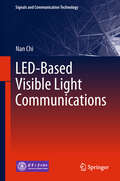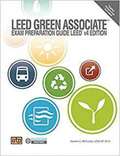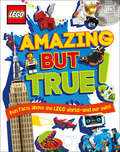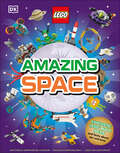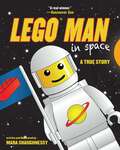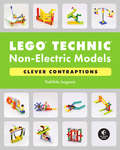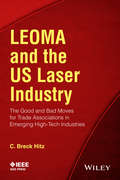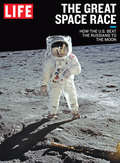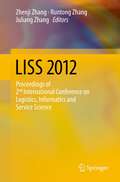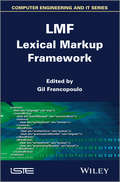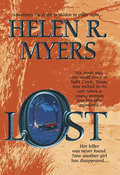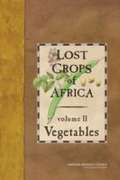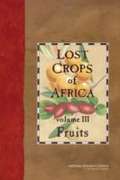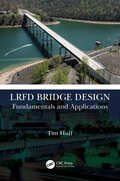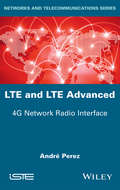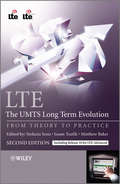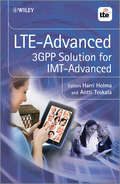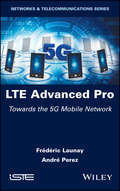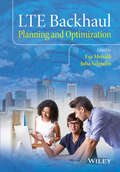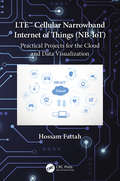- Table View
- List View
LED-Based Visible Light Communications (Signals and Communication Technology)
by Nan ChiThe book systematically introduces the visible light communication (VLC) technology in detail. Basic concepts and how to realize the system are both illustrated, including the transmitter, channel, and the receiver. In addition, a good many experimental results are presented to help readers further understand the VLC technologies. The upper-layer protocols of visible light communication system and the technology trends are also discussed. This book can be a good reference work for researchers, engineers, and graduate students in the fields of communications, LED, and optics.
LEED Green Associate Exam Preparation Guide (v4 Edition)
by Heather C. McCombs<p>The LEED Green Associate Exam Preparation Guide, LEED v4 Edition is designed to help you pass the LEED Green Associate exam. The exam prep guide captures the critical points you need to know about green building. It also reflects the structure of the exam knowledge and task domains to organize foundational concepts in green building and LEED. <p>The exam prep guide will help you prepare for the exam by emphasizing key terms and providing application learning through practice questions. This resource is intended to be used in conjunction with the exam primary references, including the LEED Core Concepts Guide. Access to a variety of digital resources that enhance learning is also included with this guide.</p>
LEGO Amazing But True: Fun Facts About the LEGO World - and Our Own!
by Catherine Saunders Julia March Elizabeth DowsettAn eye-popping fact book with a LEGO twist – discover amazing information about the world around us with the help of LEGO minifigures and bricks! Did you know a Goliath spider weighs the same as 75 2x4 LEGO bricks? Or that LEGO bricks and minifigures in various forms have travelled to Saturn, Mars, and the International Space Station? And did you know the Taj Mahal gets a mud pack treatment to remove pollution stains? Or that hummingbirds are the only birds that fly backwards? From unbelievable space and nature facts, to mind-boggling inventions and technology trivia, children will be amazed and entertained with incredible information about the LEGO world and our own. ©2022 The LEGO Group.
LEGO Amazing Space: Fantastic Building Ideas and Facts About Our Amazing Universe
by Arwen HubbardDiscover the furthest frontiers of space – and learn to build the Universe’s most incredible sights!Explore the wonders of the Universe without even putting on a spacesuit! Take a tour of planets, stars, galaxies, and even alien worlds far away from Earth. Discover how the Big Bang created all the worlds that make up the Universe; find out what’s in a black hole and learn how stars are born and why they die. Go on a spacewalk, drive a Mars Rover, dock with the International Space Station, and launch a probe to make contact with extraterrestrials! With more than 150 out-of-this-world LEGO models to inspire you, what will you build?
LEGO Man in Space: A True Story
by Mara ShaughnessyThe true story of two boys who launched a Lego Man into space! With over 3 million views on YouTube and covered by almost every major news outlet in the world, the story of how two boys launched a Lego man 80,000 feet
LEGO Man in Space: A True Story
by Mara ShaughnessyThe true story of two boys who launched a LEGO man into space! With over 3 million views on YouTube and covered by almost every major news outlet in the world, the story of how two boys, Matthew Ho and Asad Muhammad, launched a LEGO man 80,000 feet into space using a weather balloon, a homemade parachute, and a video camera is truly an inspirational story for all ages. Now you can follow along with the plucky little &“Legonaut&” as he explains just how he became the very first LEGO Man in Space. With bright, original illustrations and loads of fun space facts and activities, kids everywhere will go wild for this true tale of a Legonaut legend and his space adventure. A triumph of science and curiosity, this children&’s book is the first and only book to tell the story of how Mathew Ho and Asad Muhammad accomplished this amazing feat.LEGO Man in Space includes a resource guide for teachers with science activities, classroom crafts and games, and more!
LEGO Technic Non-Electric Models: Clever Contraptions
by Yoshihito IsogawaMaster builder and LEGO luminary Yoshihito Isogawa helps you build more than 100 creative, non-electric models with LEGO Technic parts. Part of a two-volume set.This book in the LEGO Technic Non-Electric Models series features 106 motor-free mechanisms for you to build and operate. Each project includes full-color photographs from multiple angles and illustrated Technic parts to help you follow along. The models range from practical tools for lifting, gripping, shooting, and measuring to working gadgets that demonstrate principles of mechanical engineering. The Technic models in Clever Contraptions require no electric elements or sensors. Instead, you&’ll use cranks, winches, doors, and rotators to operate devices including wind turbines, spinning tops, grabbing tools, and a spirograph. The clever kinetic ideas at play will inspire you to create your own mechanicals marvels. This Technic guide is part of a series, and the brainchild of master builder Yoshihito Isogawa. Each book in the series is filled with vibrant photos of Isogawa&’s unique non-electric models, which will fire up the imaginations of LEGO builders of all ages.Imagine. Create. Invent. Now, what will you build?
LEGO Technic Non-Electric Models: Simple Machines
by Yoshihito IsogawaMaster builder and LEGO luminary Yoshihito Isogawa helps you build more than 100 creative, non-electric models with LEGO Technic parts. Part of a two-volume set.This book in the LEGO Technic Non-Electric Models series features 141 motor-free devices for you to build and operate. Each project includes full-color photographs from multiple angles and illustrated Technic parts to help you follow along. The models range from basic mechanisms that showcase the power of gears and rotation to moving vehicles that demonstrate linear, oscillating, rotary, and reciprocating motion. The Technic models in Simple Machines require no electric elements or sensors. Instead, they operate with cranks, chains, cams, rack-and-pinion gears, rubber bands, weights, and flywheels. As you explore these projects and develop your building skills, you&’ll be inspired to create your own mechanical marvels. This Technic guide is part of a series, and the brainchild of master builder Yoshihito Isogawa. Each book in the series is filled with vibrant photos of Isogawa&’s unique non-electric models, which will fire up the imaginations of LEGO builders of all ages. Imagine. Create. Invent. Now, what will you build?
LEO the Maker Prince: Journeys in 3D Printing
by Carla DianaLEO the Maker Prince teaches children (both young and old) about 3D printing by following Carla and LEO's journey through Brooklyn. LEO is a walking, talking robot who has the magical ability to to print (in plastic) any object that Carla draws. The other robots have their own special capabilities: H1-H0 prints in metal, Sinclair-10 can find and print objects from a huge catalog of designs, and the others (including AL1C3-D, IRIS-7, and NiXie) have unique talents, too. Readers can come along for the journey, too: all of the objects in the book are printable one way or another.
LEO, Inventor Extraordinaire
by Luke Xavier CunninghamIn this middle-school adventure mystery perfect for puzzle solvers, a young orphan named Leo discovers clues to his past when he finds a series of tunnels below his school. But to unlock the answers, he&’ll need every skill and invention he has—even if his inventions don&’t always work.A &“lifer&” at the secluded Academy of Florence, Leo has never met his parents ... or anyone in his family for that matter. His current &“family&” is his mechanical monkey and robot lion, who along with his charming best friend and fellow lifer, Savvy, only get him into trouble. But after Leo&’s latest experiment goes catastrophically wrong, he finds a mysterious clue that opens an underground maze—one that seems to have been created for him to solve.Leo hopes the tunnels will help him discover the identities of his parents and the reason he&’s an orphan in the first place. Instead, he finds that his past and possibly even his future is somehow linked to the innovative Wynn Toys company, whose genius president mysteriously disappeared years before.Leo must use his creativity and scientific know-how to revive the toy company, oust its dastardly leader, and discover the fate of his real family.LEO, Inventor Extraordinaire:Is perfect for kids 8 to 12 who enjoy action, adventure, humor, and mysteryIs like The DaVinci Code for kids, with robots, wacky inventions, and puzzles to solveContains almost 60 pieces of original black and white artworkEncourages imagination and the development of STEAM skills&“In LEO, Inventor Extraordinaire, Luke Cunningham has created an utterly engaging and charismatic protagonist and an absorbing mystery filled with spectacular inventions, vivid action, an occasional life lesson, and a hearty dose of humor.&” —Clinton Kelly, TV personality and host
LEOMA and the US Laser Industry: The Good and Bad Moves for Trade Associations in Emerging High-Tech Industries
by C. Breck HitzThis book describes the approaches, both successful and not, to the political and infrastructure issues addressed by the trade association. The intent is to provide guidance to those confronting similar issues, and help them avoid unsuccessful approaches. Includes end-of-chapter summaries. Example of documents and approaches that LEOMA used successfully are included and could serve as a guide to other trade associations. Chapter 5 includes figures presenting the unique and effective graphical approach that LEOMA use to improve US national-security export controls.
LIFE The Great Space Race: How the U.S. Beat the Russians to the Moon
by The Editors of LifeForged in the cauldron of both Nazi Germany and the Soviet Gulag-and fueled by the development of nuclear weapons during the Cold War-The Great Space Race is an epic drama filled with triumphs and tragedies, both technological and deeply human, that riveted the U.S. even as it seemed the fate of the free world (perhaps even the world itself ) hung in the balance.The book features rare, exclusive photographs and thrilling reporting, reflecting LIFE's insider access to the astronauts, their families, and their missions: Go behind the scenes as John Glenn trains for his historic flight, and marvel with Joan Aldrin as her husband, "Buzz," becomes the second man to set foot on the lunar surface. Join Anne Morrow Lindbergh and her aviator husband, Charles, as they visit the Apollo 8 crew on the eve of their historic holiday mission. Watch from the top of the rocket launcher as LIFE's photographer captures the launch of the first manned trip to the moon....and much more.
LISS 2012
by Juliang Zhang Runtong Zhang Zhenji ZhangInformation and communication technology has helped to provide a more effective network infrastructure and development platform for logistics and service operations. In order to meet the needs of consumers, and particularly to promote low-carbon development processes, new types of services will also emerge. LISS 2012 is a prime international forum for both researchers and industry practitioners to exchange the latest fundamental advances in the state of the art and practice of logistics, informatics, service operations and service science. Experts and researchers from related fields will discuss current issues and future development opportunities, discuss and analyze developing trends and exchange the latest research and academic thought. The theme of the conference is Logistics and Service Science based on the Internet of Things.
LMF Lexical Markup Framework
by Gil FrancopouloThe community responsible for developing lexicons for Natural Language Processing (NLP) and Machine Readable Dictionaries (MRDs) started their ISO standardization activities in 2003. These activities resulted in the ISO standard – Lexical Markup Framework (LMF). After selecting and defining a common terminology, the LMF team had to identify the common notions shared by all lexicons in order to specify a common skeleton (called the core model) and understand the various requirements coming from different groups of users. The goals of LMF are to provide a common model for the creation and use of lexical resources, to manage the exchange of data between and among these resources, and to enable the merging of a large number of individual electronic resources to form extensive global electronic resources. The various types of individual instantiations of LMF can include monolingual, bilingual or multilingual lexical resources. The same specifications can be used for small and large lexicons, both simple and complex, as well as for both written and spoken lexical representations. The descriptions range from morphology, syntax and computational semantics to computer-assisted translation. The languages covered are not restricted to European languages, but apply to all natural languages. The LMF specification is now a success and numerous lexicon managers currently use LMF in different languages and contexts. This book starts with the historical context of LMF, before providing an overview of the LMF model and the Data Category Registry, which provides a flexible means for applying constants like /grammatical gender/ in a variety of different settings. It then presents concrete applications and experiments on real data, which are important for developers who want to learn about the use of LMF. Contents 1. LMF – Historical Context and Perspectives, Nicoletta Calzolari, Monica Monachini and Claudia Soria. 2. Model Description, Gil Francopoulo and Monte George. 3. LMF and the Data Category Registry: Principles and Application, Menzo Windhouwer and Sue Ellen Wright. 4. Wordnet-LMF: A Standard Representation for Multilingual Wordnets, Piek Vossen, Claudia Soria and Monica Monachini. 5. Prolmf: A Multilingual Dictionary of Proper Names and their Relations, Denis Maurel, Béatrice Bouchou-Markhoff. 6. LMF for Arabic, Aida Khemakhem, Bilel Gargouri, Kais Haddar and Abdelmajid Ben Hamadou. 7. LMF for a Selection of African Languages, Chantal Enguehard and Mathieu Mangeot. 8. LMF and its Implementation in Some Asian Languages, Takenobu Tokunaga, Sophia Y.M. Lee, Virach Sornlertlamvanich, Kiyoaki Shirai, Shu-Kai Hsieh and Chu-Ren Huang. 9. DUELME: Dutch Electronic Lexicon of Multiword Expressions, Jan Odijk. 10. UBY-LMF – Exploring the Boundaries of Language-Independent Lexicon Models, Judith Eckle-Kohler, Iryna Gurevych, Silvana Hartmann, Michael Matuschek and Christian M. Meyer. 11. Conversion of Lexicon-Grammar Tables to LMF: Application to French, Éric Laporte, Elsa Tolone and Matthieu Constant. 12. Collaborative Tools: From Wiktionary to LMF, for Synchronic and Diachronic Language Data, Thierry Declerck, Pirsoka Lendvai and Karlheinz Mörth. 13. LMF Experiments on Format Conversions for Resource Merging: Converters and Problems, Marta Villegas, Muntsa Padró and Núria Bel. 14. LMF as a Foundation for Servicized Lexical Resources, Yoshihiko Hayashi, Monica Monachini, Bora Savas, Claudia Soria and Nicoletta Calzolari. 15. Creating a Serialization of LMF: The Experience of the RELISH Project, Menzo Windhouwer, Justin Petro, Irina Nevskaya, Sebastian Drude, Helen Aristar-Dry and Jost Gippert. 16. Global Atlas: Proper Nouns, From Wikipedia to LMF, Gil Francopoulo, Frédéric Marcoul, David Cau
LMIs in Control Systems: Analysis, Design and Applications
by Guang-Ren Duan Hai-Hua YuAlthough LMI has emerged as a powerful tool with applications across the major domains of systems and control, there has been a need for a textbook that provides an accessible introduction to LMIs in control systems analysis and design. Filling this need, LMIs in Control Systems: Analysis, Design and Applications focuses on the basic analysis and d
LOST
by Helen R. MyersWhen Faith Ramey's abandoned car is discovered, the town can't help feeling an unwelcome sense of déjà vu. Police Chief Jared Morgan doesn't to believe there's a connection, but Faith's sister, Michaele, is beginning to suspect otherwise. She has sacrificed everything-including her true feelings for Jared-to ensure her younger sister's future. Now, losing Faith could do more than crush her...it might destroy the entire community.As secrets and scandals are exposed, old fears-and new-spawn doubt and suspicion. Is a sinister stranger lurking behind the murder and Faith's disappearance-or does something in Split Creek have blood on their hands? Only Michaele's fierce determination-and her trust in Jared-will help her see the truth hidden in plain sight.
LOST CROPS of AFRICA: volume II Vegetables
by National Research Council of the National AcademiesThis report is the second in a series of three evaluating underexploited African plant resources that could help broaden and secure Africa's food supply. The volume describes the characteristics of 18 little-known indigenous African vegetables (including tubers and legumes) that have potential as food- and cash-crops but are typically overlooked by scientists and policymakers and in the world at large. The book assesses the potential of each vegetable to help overcome malnutrition, boost food security, foster rural development, and create sustainable landcare in Africa. Each species is described in a separate chapter, based on information gathered from and verified by a pool of experts throughout the world. Volume I describes African grains and Volume III African fruits.
LOST CROPS of AFRICA: volume III
by National Research Council of the National AcademiesThis book is the third in a series evaluating underexploited African plant resources that could help broaden and secure Africa's food supply. The volume describes 24 little-known indigenous African cultivated and wild fruits that have potential as food- and cash-crops but are typically overlooked by scientists, policymakers, and the world at large. The book assesses the potential of each fruit to help overcome malnutrition, boost food security, foster rural development, and create sustainable landcare in Africa. Each fruit is also described in a separate chapter, based on information provided and assessed by experts throughout the world. Volume I describes African grains and Volume II African vegetables.
LRFD Bridge Design: Fundamentals and Applications
by Tim HuffThis book examines and explains material from the 9th edition of the AASHTO LRFD Bridge Design Specifications, including deck and parapet design, load calculations, limit states and load combinations, concrete and steel I-girder design, bearing design, and more. With increased focus on earthquake resiliency, two separate chapters– one on conventional seismic design and the other on seismic isolation applied to bridges– will fully address this vital topic. The primary focus is on steel and concrete I-girder bridges, with regard to both superstructure and substructure design.Features: Includes several worked examples for a project bridge as well as actual bridges designed by the author Examines seismic design concepts and design details for bridges Presents the latest material based on the 9th edition of the LRFD Bridge Design Specifications Covers fatigue, strength, service, and extreme event limit states Includes numerous solved problems and exercises at the end of each chapter to illustrate the concepts presented LRFD Bridge Design: Fundamentals and Applications will serve as a useful text for graduate and upper-level undergraduate civil engineering students as well as practicing structural engineers.
LTE & LTE Advanced
by André PerezThis book presents the technical characteristics of the two radio network interfaces of mobile 4G, LTE and LTE Advanced, based on Release 8, 9 and 10 of the 3GPP specifications. Points covered include a detailed description of various components of the radio interface. RRC signaling messages used to establish the connection, enabling the security, the paging, the establishment and the release of dedicated and default support and the handover. The PDCP ensures the security of the transmission and allows the recovery during handover and the compression of the headers. The RLC protocol defines the transmission modes with or without acknowledgment. The MAC protocol determines the random access, the data transfer, the timing advance, the scheduling and the discontinuous reception. The physical layer includes a description of the methods of multiplexing (time, frequency and space) and the various signals and physical channels.
LTE - The UMTS Long Term Evolution
by Stefania Sesia Issam Toufik Matthew Baker"Where this book is exceptional is that the reader will not just learn how LTE works but why it works"Adrian Scrase, ETSI Vice-President, International Partnership ProjectsFollowing on the success of the first edition, this book is fully updated, covering the latest additions to LTE and the key features of LTE-Advanced.This book builds on the success of its predecessor, offering the same comprehensive system-level understanding built on explanations of the underlying theory, now expanded to include complete coverage of Release 9 and the developing specifications for LTE-Advanced. The book is a collaborative effort of more than 40 key experts representing over 20 companies actively participating in the development of LTE, as well as academia. The book highlights practical implications, illustrates the expected performance, and draws comparisons with the well-known WCDMA/HSPA standards. The authors not only pay special attention to the physical layer, giving an insight into the fundamental concepts of OFDMA-FDMA and MIMO, but also cover the higher protocol layers and system architecture to enable the reader to gain an overall understanding of the system.Key New Features:Comprehensively updated with the latest changes of the LTE Release 8 specifications, including improved coverage of Radio Resource Management RF aspects and performance requirementsProvides detailed coverage of the new LTE Release 9 features, including: eMBMS, dual-layer beamforming, user equipment positioning, home eNodeBs / femtocells and pico cells and self-optimizing networksEvaluates the LTE system performanceIntroduces LTE-Advanced, explaining its context and motivation, as well as the key new features including: carrier aggregation, relaying, high-order MIMO, and Cooperative Multi-Point transmission (CoMP).Includes an accompanying website containing a complete list of acronyms related to LTE and LTE-Advanced, with a brief description of each (http://www.wiley.com/go/sesia_theumts)This book is an invaluable reference for all research and development engineers involved in implementation of LTE or LTE-Advanced, as well as graduate and PhD students in wireless communications. Network operators, service providers and R&D managers will also find this book insightful.
LTE Advanced
by Antti Toskala Harri HolmaFrom the editors of the highly successful LTE for UMTS: Evolution to LTE-Advanced, this new book examines the main technical enhancements brought by LTE-Advanced, thoroughly covering 3GPP Release 10 specifications and the main items in Release 11. Using illustrations, graphs and real-life scenarios, the authors systematically lead readers through this cutting-edge topic to provide an outlook on existing technologies as well as possible future developments.The book is structured to follow the main technical areas that will be enhanced by the LTE-Advanced specifications. The main topics covered include: Carrier Aggregation; Multiantenna MIMO Transmission, Heterogeneous Networks; Coordinated Multipoint Transmission (CoMP); Relay nodes; 3GPP milestones and IMT-Advanced process in ITU-R; and LTE-Advanced Performance Evaluation.Key features:Leading author and editor team bring their expertise to the next generation of LTE technologyIncludes tables, figures and plots illustrating the concepts or simulation results, to aid understanding of the topic, and enabling readers to be ahead of the technological advances
LTE Advanced Pro: Towards the 5G Mobile Network
by André Perez Frédéric LaunayThis book presents LTE evolution towards 5G mobile communication and the emergence of new requirements for MBB, MTC and LLC services. As LTE technologies evolve, LTE Advanced Pro dramatically increases cell capacity and user data rates for the MBB unicast service. Such requirements are obtained using full-dimension MIMO, carrier aggregation (on either licensed or unlicensed frequency bands) and dual connectivity. To improve the efficiency of same-content delivery to multiple users, 3GPP proposes a group communications service over LTE and defines mission critical push-to-talk (MCPTT) for dedicated public safety services. Complementary low-cost and low-power modems with enhanced coverage and massive connectivity are emerging. Thus, this book also discusses the need for LTE to support low-rate transmission and high-latency communication for MTC services.
LTE Backhaul: Planning and Optimization
by Esa Markus Metsälä Juha T.T. SalmelinThe aim of this book is to enable network planners to realize and maintain cost efficient LTE backhaul networks, which meet the necessary performance requirements. Through an introduction to the technology background, the economical modelling, the dimensioning theory, planning and optimization processes and relevant network management aspects, the reader shall obtain all relevant information to achieve good backhaul results in their own network environment. It is aimed at network planners and other experts with responsibilities for LTE IP network dimensioning, LTE network planning, providing and managing leased lines, business management, LTE IP network operation and optimization.
LTE Cellular Narrowband Internet of Things (NB-IoT): Practical Projects for the Cloud and Data Visualization
by Hossam FattahNB-IoT is the Internet of Things (IoT) technology used for cellular communication. NB-IoT devices deliver much better capability and performance, such as: increased area coverage of up to one kilometer; a massive number of devices—up to 200,000—per a single base-station area; longer battery lifetime of ten years; and better indoor and outdoor coverage for areas with weak signal, such as underground garages. The cellular NB-IoT technology is a challenging technology to use and understand. With more than 30 projects presented in this book, covering many use cases and scenarios, this book provides hands-on and practical experience of how to use the cellular NB-IoT for smart applications using Arduino™, Amazon Cloud, Google Maps, and charts. The book starts by explaining AT commands used to configure the NB-IoT modem; data serialization and deserialization; how to set up the cloud for connecting NB-IoT devices; setting up rules, policy, security certificates, and a NoSQL database on the cloud; how to store and read data in the cloud; how to use Google Maps to visualize NB-IoT device geo-location; and how to use charts to visualize sensor datasets. Projects for Arduino are presented in four parts. The first part explains how to connect the device to the mobile operator and cellular network; perform communication using different network protocols, such as TCP, HTTP, SSL, or MQTT; how to use GPS for geo-location applications; and how to upgrade NB-IoT modem firmware over the air. The second part explains the microcontroller unit and how to build and run projects, such as a 7-segment display or a real-time clock. The third part explains how NB-IoT can be used with sensor devices, such as ultrasonic and environmental sensors. Finally, the fourth part explains how NB-IoT can be used to control actuators, such as stepper motors and relays. This book is a unique resource for understanding practical uses of the NB-IoT technology and serves as a handbook for technical and non-technical readers who are looking for practicing and exercising the cellular NB-IoT technology. The book can be used by engineers, students, researchers, system integrators, mobile operators’ technical staff, and electronics enthusiasts. To download the software which can be used with the book, go to: https://github.com/5ghub/NB-IoT About the Author: Hossam Fattah is a technology expert in 4G/5G wireless systems and networking. He received his Ph.D. in Electrical and Computer Engineering from University of British Columbia, Vancouver, Canada in 2003. He received his Master of Applied Science in Electrical and Computer Engineering from University of Victoria, Victoria, Canada in 2000. He completed his B.Sc. degree in Computers and Systems Engineering from Al-Azhar University, Cairo, Egypt in 1995. Between 2003 and 2011, he was in academia and industry, including Texas A&M University. Between 2011 and 2013, he was with Spirent Communications, NJ, USA. Since 2013, he has been with Microsoft, USA. He is also an affiliate associate professor at University of Washington, Tacoma, WA, USA, teaching graduate courses on IoT and distributed systems and collaborating on 5G research and innovations. He has had many patents and technical publications in conferences and journals. He is a registered professional Engineer with the Association of Professional Engineers, British Columbia, Canada. He is the author of the recent book 5G LTE Narrowband Internet of Things (NB-IoT). His research interest is in wireless communications and radio networks and protocols, cellular quality of service, radio resource management, traffic and packet scheduling, network analytics, and mobility.
